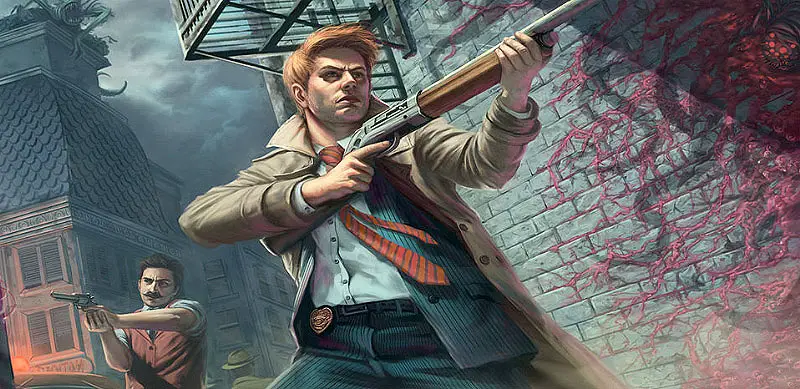
Eventually, all investigators have to face their fears and do battle with the Mythos. Whenever an investigator enters combat with a monster, resolve the following steps, in order.
I. Horror Check

First, the alien nature of the Mythos threatens to overwhelm the investigator's mind. This is represented by a Horror check.
A Horror check is a skill check using the investigator's Will value. This value is modified by the monster's horror rating (found in the lower-left corner of its combat side).
The difficulty of this check is always 1 unless the monster has a special ability that states otherwise.
If the investigator passes the check, nothing happens. If he fails the check, the investigator loses the amount of Sanity shown underneath the monster's horror rating. The player discards the appropriate number of Sanity tokens from his investigator sheet. An investigator reduced to zero Sanity tokens is driven insane.
Whether he passes the check or not, an investigator only needs to make one Horror check each time he does battle with a monster. If the investigator successfully evades the monster in the first place, he never needs to make a Horror check at all.
II. Fight or Flee
Next, the investigator must choose: He may either attempt to flee or fight the monster.
A. Flee
The investigator tries to evade the monster, using an Evade check just as described under "Evading Monsters" earlier in these rules. If he passes the check, he eludes the monster and the battle immediately ends. If he fails the check, the monster deals its combat damage to the investigator and the battle continues.
B. Fight
If the investigator fights the monster, he makes a Combat check. A Combat check is a skill check using the investigator's Fight value. This value is modified by the monster's combat rating (printed in the lower-right corner of its combat side). The difficulty of this check is equal to the monster's toughness, which is represented by the number of "blood drop" icons that appear in the lower center of the monster's combat side.
If the investigator passes the Combat check, he defeats the monster. The investigator's player removes the marker from the board and places it in front of him as a monster trophy.
If the investigator fails the check, the monster deals its combat damage to him.
Example: After failing his Horror check, Ashcan Pete decides to fight the Star Spawn rather than attempt to flee. Pete's Fight is 6 and the Star Spawn's combat rating is -3, so Pete rolls three dice. The Star Spawn's toughness is 3 (the difficulty for the check), so Pete must succeed on all three dice to defeat the monster. If Pete succeeds, he takes the Star Spawn marker and places it in front of him as a monster trophy. If he fails, the Star Spawn deals its combat damage to Pete.
Important: If a monster's toughness is greater than 1, partial success has no effect on it. A monster must be completely defeated in one Combat check or it ignores all successes the investigator rolled.
III. Monster Damage

Each time an investigator fails to evade or defeat a monster, the monster deals its combat damage to the investigator. The amount of combat damage a monster deals is printed below its combat rating. The investigator loses Stamina equal to this number. The player discards the appropriate number of Stamina tokens from his investigator sheet. An investigator reduced to zero Stamina tokens is knocked unconscious.
Note that some monsters have abilities that add some special effect to their combat damage. For example, the Nightgaunt drops the investigator through the nearest open gate instead of causing the investigator to lose Stamina tokens.
If the investigator remains conscious, sane, and in the same space as the monster after this step is resolved, the combat continues. Return to step 2, Fight or Flee, and continue the combat until it is resolved.
Example: Pete fails the Combat check, so the Star Spawn deals its combat damage to him. The Star Spawn's combat damage is 3, so Pete loses three Stamina. Battered, bruised, and more than a little crazy, Pete prepares for another round of combat.
Using Weapons and Spells in Combat
Investigators can gain a valuable edge in combat by using weapons and spells. The biggest advantage of weapons is that they automatically grant bonuses on Combat checksno additional skill checks are required to use them. However, most weapons grant Physical Combat bonuses, which have no effect at all against many Mythos monsters.
Spells, on the other hand, grant Magical Combat bonuses. These are effective against almost every monster in Arkham Horror. An investigator must successfully cast a spell to gain its benefits. If an investigator fails to cast a spell, it provides no bonuses for the combat at all. In other words, spells are more powerful and versatile than weapons, but they are not always a sure thing.
Weapon and Spell Limits
There is a limitation on the number of weapons and spells an investigator may use at once. This limitation is represented by "hand" icons printed in the lower-left corner of each weapon and spell card. Each investigator may use any combination of weapons and spells and add their skill bonuses together, as long as their combined number of hand icons does not exceed two. Note that a spell requires the number of hands printed on the card, even if the investigator fails to cast it.
A spell or weapon that gives you a bonus (even one that says it lasts until the end of combat) only continues to give you the bonus while you devote the required number of hands to it. You can choose to switch weapons/spells in later combat rounds, but as soon as you "release" a spell or weapon, it stops working for you.
Similarly, spells that are refreshed (such as at the beginning of each combat round in the final battle) cease to work and must be re-cast.
Continue Reading


